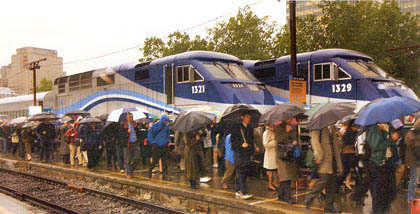 |
 |
|
|
|
|
|
Summer
2004

Canadian Pacific Railway Employee
Communications
Room 500 401-9th Ave S.W. Calgary AB T2P
4Z4
I'll Take the
Train

Fifty-five daily commuter
trains serve about 20,000 riders.
Increasingly, harried city
commuters opt for the comfort and reliability of a railway coach.
Passenger railway service is the public face of railroading; and it's all
smiles lately for CPR's commuter operations in the Montreal Service Area.
Gone are the days when government regulators forced commuter rail service
providers to go it alone, turning a blind eye to the dicey economics of
paying for track and equipment that sits idle outside of weekday rush
hours. Today, partnerships with governments recognize the tangible benefits
that efficient commuter services afford the public, as well as their
potential role as a city-shaping tool.
"The 55 commuter trains we operate daily in and out of the City of
Montreal on three separate subdivisions serve about 20,000 riders, taking
thousands of cars off the over-burdened road system",
said Johane Lemay, CPR's director of Montreal commuter rail service.
"The success of the operation in recent years has warranted
operational, financial, and safety studies of expansion on two additional
lines".
CPR's original commuter service to the Lakeshore area of Montreal's West
Island is nearly as old as the railway itself. Windsor Station, and the
access track through Montreal West and Westmount - then known as Montreal
Junction and Cote St. Antoine, respectively - was opened for train service
on 4 Feb 1889. The lines from Windsor Station (now Lucien
L'Allier) to Blainville and Delson built a respectable local service
between the two World Wars, mostly catering to farmers shipping produce to
the city and vacationers looking for a peaceful respite in the country.
Key performance statistics in recent years have been impressive. In 2003,
Montreal commuter services set a target of 96 percent for
on-time performance and exceeded that lofty goal on all three
lines; service to Blainville came in at 98.1 percent. In the same year,
there were no train accidents or cardinal rule violations.
Johane credits the good work from her six-person management
team and the great service they get from CPR's mechanical services, train
crews, and track forces. Good working relationships with the Network
Management Centre (NMC), CPR Police Service and, of course, the local
transportation agency, AMT (Agence Metropolitaine de Transport), are also
essential elements of the successful operation.
The commuter service contributes to the vitality of the Montreal Service
Area. "AMT is confident we can provide good value and good
service", she said. "While CPR develops revenue that helps
support maintenance and infrastructure repairs on the subdivisions".
Together, CPR and AMT have recently installed Central Traffic Control (CTC)
on the Montreal & Ottawa subdivision and have completed a new
over-night storage facility for commuter locomotives and
coaches in Vaudreuil, Quebec. They are also upgrading the roadbed to allow
for 55 mph operations on the Lachute subdivision.
And the Montreal commuter team and AMT are in the midst of negotiations to
sign a long-term contract for maintenance services by our
mechanical folks at St. Luc yard.
In another positive development, the venerable 800-series AMT
coaches on the lakeshore run which date back to the CPR steam era are being
retired in favour of 22 new double-decked cars that AMT has
ordered from Bombardier out of Thunder Bay, Ontario. The new cars are
expected to be in service by early 2005.
"Stability in the relationship between AMT and CPR is good for both
parties", Johane said. "The confidence we have in one another
allows us to build a long-term strategic plan and grow
together in a way that benefits both Montreal and the CPR".
This Momentum
article is copyright 2004 by Canadian Pacific Railway and is reprinted
here with their permission. All photographs, logos, and trademarks are
the property of the Canadian Pacific Railway Company.
|
|
|
|